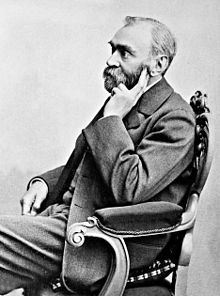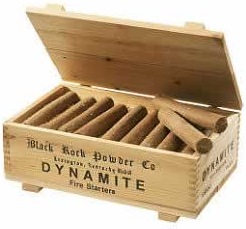Alfred Nobel's Bibliography


Alfred Bernhard Nobel (21 October 1833 – 10 December 1896) was a Swedish chemist, engineer, innovator, and armaments manufacturer. He was the inventor of dynamite. Nobel also owned Bofors, which he had redirected from its previous role as primarily an iron and steel producer to a major manufacturer of cannon and other armaments. Nobel held 350 different patents, dynamite being the most famous. He used his fortune to posthumously institute the Nobel Prizes. The synthetic element nobelium was named after him. His name also survives in modern-day companies such as Dynamit Nobel and Akzo Nobel, which are descendents of the companies Nobel himself established.
LIFE & CAREER:
Born in Stockholm, Alfred Nobel was the fourth son of Immanuel Nobel (1801–1872), an inventor and engineer, and Andriette Ahlsell Nobel (1805–1889).The couple married in 1827 and had eight children, although, beset by poverty, only Alfred and his three brothers survived past childhood. Through his father, Alfred Nobel was a descendant of the Swedish scientist Olaus Rudbeck (1630-1702) and the boy, in his turn, was interested in engineering, and especially explosives, from a young age, learning the basic principles from his father.
Following various business failures, Nobel's father moved to Saint Petersburg in 1837 and grew successful there as a manufacturer of machine tools and explosives. He invented modern plywood and started a "torpedo" works. In 1842, the family joined him in the city. Now prosperous, his parents were able to send Nobel to private tutors and the boy excelled in his studies, particularly in chemistry and languages, achieving fluency in English, French, German and Russian. For 18 months, during 1841–1842, Nobel went to the only school he ever attended as a child, the Jacobs Apologistic School in Stockholm.
As a young man, Nobel studied with chemist Nikolai Zinin, then in 1850 went to Paris to further the work and at 18, he went to the United States for four years to study chemistry, collaborating for a short period under inventor John Ericsson who designed the American Civil War ironclad USS Monitor. Nobel filed his first patent, for a gas meter, in 1857.
The family factory produced armaments for the Crimean War (1853 – 1856) but had difficulty switching back to regular domestic production when the fighting ended and they filed for bankruptcy. In 1859, Nobel's father left his factory in the care of the second son, Ludvig Nobel (1831–1888), who greatly improved the business. Nobel and his parents returned to Sweden from Russia and Nobel devoted himself to the study of explosives, and especially to the safe manufacture and use of nitroglycerine (discovered in 1847 by Ascanio Sobrero, one of his fellow students under Théophile-Jules Pelouze at the University of Turin). Nobel invented a detonator in 1863 and in 1865 he designed the blasting cap.
On 3 September 1864 a shed, used for the preparation of nitroglycerin, exploded at the factory in Heleneborg Stockholm, killing five people, including Nobel's younger brother Emil. Dogged by more minor accidents but unfazed, Nobel went on to build further factories, focusing on improving the stability of the explosives he was developing. Nobel invented dynamite in 1867, a substance easier and safer to handle than the more unstable nitroglycerin. Dynamite was patented in the US and the UK and was used extensively in mining and the building of transport networks internationally. In 1875 Nobel invented gelignite, more stable and powerful than dynamite, and in 1887 patented ballistite, a forerunner of cordite.
Nobel was elected a member of the Royal Swedish Academy of Sciences in 1884, the same institution that would later select laureates for two of the Nobel prizes, and he received an honorary doctorate from Uppsala University in 1893.
Nobel's brothers Ludvig and Robert exploited oilfields along the Caspian Sea and became hugely rich in their own right. Nobel invested in these and amassed great wealth through the development of these new oil regions. During his life Nobel issued 350 patents internationally and by his death had established 90 armaments factories, despite his belief in pacifism.
In 1891, following the death of his mother and his brother Ludvig and the end of a long standing relationship, Nobel moved from Paris to San Remo, Italy. Suffering from angina, Nobel died at home, of a cerebral haemorrhage in 1896. Unbeknownst to his family, friends or colleagues, he had left most of his wealth in trust, in order to fund the awards that would become known as the Nobel Prizes. He is buried in Norra begravningsplatsen in Stockholm
PERSONAL LIFE:
Nobel travelled for much of his business life, maintaining companies in various countries in Europe and North America and keeping a permanent home in Paris from 1873 to 1891. He remained a solitary character, given to periods of depression. Though Nobel remained unmarried, his biographers note that he had at least three loves. Nobel's first love was in Russia with a girl named Alexandra, who rejected his proposal. In 1876 Austro-Bohemian Countess Bertha Kinsky became Alfred Nobel's secretary. But after only a brief stay she left him to marry her previous lover, Baron Arthur Gundaccar von Suttner. Though her personal contact with Alfred Nobel had been brief, she corresponded with him until his death in 1896, and it is believed that she was a major influence in his decision to include a peace prize among those prizes provided in his will. Bertha von Suttner was awarded the 1905 Nobel Peace prize, 'for her sincere peace activities'.
Nobel's third and longest-lasting relationship was with Sofie Hess who was from Vienna, whom he met in 1876.The liaison lasted for 18 years. After his death, according to his biographers Evlanoff, Fluor, and Fant, Nobel's letters were locked within the Nobel Institute in Stockholm. They were released only in 1955, to be included with the biographical data of Nobel.
Sri Kantha has suggested that 'the one personal trait of Nobel that helped him to sharpen his creativity include his talent for information access, via his multi-lingual skills. Despite the lack of formal secondary and tertiary level education, Nobel gained proficiency in six languages: Swedish, French, Russian, English, German and Italian. He also developed literary skills to write poetry in English.' His Nemesis, a prose tragedy in four acts about Beatrice Cenci, partly inspired by Percy Bysshe Shelley's The Cenci, was printed while he was dying. The entire stock except for three copies was destroyed immediately after his death, being regarded as scandalous and blasphemous. The first surviving edition (bilingual Swedish–Esperanto) was published in Sweden in 2003. The play has been translated to Slovenianvia the Esperanto version and to French. In 2010 it was published in Russia as another bilingual (Russian–Esperanto) edition.
INVENTIONS:
 |
| From Nitroglycerin to Dynamite.Alfred Nobel's Dynamite |
 |
| Invented in 1866 by Alfred Nobel, dynamite's cylindrical shape perfectly fit ... |
Nobel found that when nitroglycerin was incorporated in an absorbent inert substance like kieselguhr (diatomaceous earth) it became safer and more convenient to handle, and this mixture he patented in 1867 as 'dynamite'. Nobel demonstrated his explosive for the first time that year, at a quarry in Redhill, Surrey, England. In order to help reestablish his name and improve the image of his business from the earlier controversies associated with the dangerous explosives, Nobel had also considered naming the highly powerful substance "Nobel's Safety Powder", but settled with Dynamite instead, referring to the Greek word for 'power'.
Nobel later on combined nitroglycerin with various nitrocellulose compounds, similar to collodion, but settled on a more efficient recipe combining another nitrate explosive, and obtained a transparent, jelly-like substance, which was a more powerful explosive than dynamite. 'Gelignite', or blasting gelatin, as it was named, was patented in 1876; and was followed by a host of similar combinations, modified by the addition of potassium nitrate and various other substances. Gelignite was more stable, transportable and conveniently formed to fit into bored holes, like those used in drilling and mining, than the previously used compounds and was adopted as the standard technology for mining in the Age of Engineering bringing Nobel a great amount of financial success, though at a significant cost to his health. An off-shoot of this research resulted in Nobel's invention of ballistite, the precursor of many modern smokeless powder explosives and still used as a rocket propellant.
THE PRIZES:
In 1888 Alfred's brother Ludvig died while visiting Cannes and a French newspaper erroneously published Alfred's obituary. It condemned him for his invention of dynamite and is said to have brought about his decision to leave a better legacy after his death. The obituary stated Le marchand de la mort est mort ("The merchant of death is dead") and went on to say, "Dr. Alfred Nobel, who became rich by finding ways to kill more people faster than ever before, died yesterday." Alfred was disappointed with what he read and concerned with how he would be remembered. On 27 November 1895, at the Swedish-Norwegian Club in Paris, Nobel signed his last will and testament and set aside the bulk of his estate to establish the Nobel Prizes, to be awarded annually without distinction of nationality. After taxes and bequests to individuals, Nobel's will gave 31,225,000 Swedish kronor (equivalent to about 1.8 billion kronor or 250 million US dollars in 2008) to fund the prizes.
The first three of these prizes are awarded for eminence in physical science, in chemistry and in medical science or physiology; the fourth is for literary work "in an ideal direction" and the fifth prize is to be given to the person or society that renders the greatest service to the cause of international fraternity, in the suppression or reduction of standing armies, or in the establishment or furtherance of peace congresses. There is no prize awarded for mathematics, but see Abel Prize.
The formulation for the literary prize being given for a work "in an ideal direction" (i idealisk riktning in Swedish), is cryptic and has caused much confusion. For many years, the Swedish Academy interpreted "ideal" as "idealistic" (idealistisk) and used it as a reason not to give the prize to important but less Romantic authors, such as Henrik Ibsen and Leo Tolstoy. This interpretation has since been revised, and the prize has been awarded to, for example, Dario Fo and José Saramago, who do not belong to the camp of literary idealism.
There was room for interpretation by the bodies he had named for deciding on the physical sciences and chemistry prizes, given that he had not consulted them before making the will. In his one-page testament, he stipulated that the money go to discoveries or inventions in the physical sciences and to discoveries or improvements in chemistry. He had opened the door to technological awards, but had not left instructions on how to deal with the distinction between science and technology. Since the deciding bodies he had chosen were more concerned with the former, the prizes went to scientists and not to engineers, technicians or other inventors.
In 2001, Alfred Nobel's great-grandnephew, Peter Nobel (b. 1931), asked the Bank of Sweden to differentiate its award to economists given "in Alfred Nobel's memory" from the five other awards. This has caused much controversy whether the Bank of Sweden Prize in Economic Sciences in Memory of Alfred Nobel is actually a "Nobel Prize"

.jpg)
Comments
Post a Comment